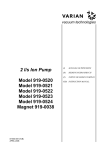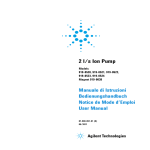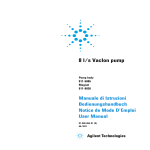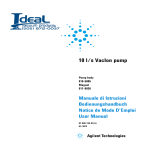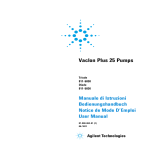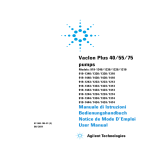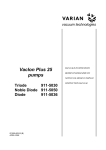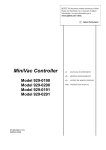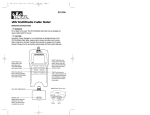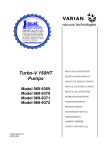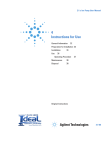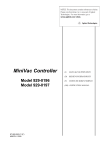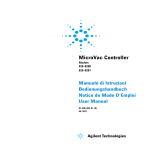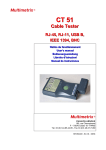Download 2ls ionpump manual 4
Transcript
2 l/s Ion Pump Model 919-0520 Model 919-0521 Model 919-0522 Model 919-0523 Model 919-0524 Magnet 919-0038 87-900-091-01(A) APRIL 2002 MANUALE DI ISTRUZIONI BEDIENUNGSHANDBUCH NOTICE DE MODE D’EMPLOI INSTRUCTION MANUAL 2 l/s Ion Pump ISTRUZIONI PER L’USO .................................................................................................... 1 GEBRAUCHSANLEITUNG ................................................................................................. 3 MODE D’EMPLOI ................................................................................................................ 5 INSTRUCTIONS FOR USE................................................................................................. 7 TECHNICAL INFORMATION .............................................................................................. 9 DESCRIPTION OF THE PUMP .....................................................................................................9 OPERATING NOTES...................................................................................................................10 TECHNICAL SPECIFICATION ....................................................................................................10 OUTLINE DRAWING ...................................................................................................................11 INSTALLATION............................................................................................................................12 Pump Assembling ..............................................................................................................12 Pump Installation................................................................................................................13 CONTROL UNIT CONNECTION.................................................................................................13 BAKEOUT ....................................................................................................................................13 UNUSUAL OPERATING CONDITIONS ......................................................................................14 PUMP TROUBLESHOOTING......................................................................................................14 2 l/s PUMP REPLACEMENT PARTS AND ACCESSORIES.......................................................14 ISTRUZIONI PER L'USO INFORMAZIONI GENERALI Questa apparecchiatura è destinata ad uso professionale. L'utilizzatore deve leggere attentamente il presente manuale di istruzioni ed ogni altra informazione addizionale fornita dalla Varian prima dell'utilizzo dell'apparecchiatura. La Varian si ritiene sollevata da eventuali responsabilità dovute all'inosservanza totale o parziale delle istruzioni, ad uso improprio da parte di personale non addestrato, ad interventi non autorizzati o ad uso contrario alle normative nazionali specifiche. Le pompe della serie 2l/s sono pompe ioniche utilizzate comunemente per applicazioni di ultra alto vuoto, grazie alla loro pulizia, capacità di pompare qualsiasi tipo di gas, e del loro funzionamento senza vibrazioni e necessità di manutenzione. Nei paragrafi seguenti sono riportate tutte le informazioni necessarie a garantire la sicurezza dell'operatore durante l'utilizzo dell'apparecchiatura. Informazioni dettagliate sono fornite nell'appendice “Technical information”. Questo manuale utilizza le seguenti convenzioni: ! PERICOLO! I messaggi di pericolo attirano l'attenzione dell'operatore su una procedura o una pratica specifica che, se non eseguita in modo corretto, potrebbe provocare gravi lesioni personali. ! ATTENZIONE! INSTALLAZIONE I messaggi di attenzione sono visualizzati prima di procedure che, se non osservate, potrebbero causare danni all'apparecchiatura. Non installare e/o utilizzare la pompa in ambienti esposti ad agenti atmosferici (pioggia, gelo, neve), polveri, gas aggressivi, in ambienti esplosivi o con elevato rischio di incendio. Durante il funzionamento, per ottenere le specifiche tecniche dichiarate, la temperatura ambiente deve essere compresa tra 0 °C e +85 °C. NOTA Le note contengono informazioni importanti estrapolate dal testo. ! ATTENZIONE! PREPARAZIONE PER L'INSTALLAZIONE La pompa deve essere tenuta sigillata finchè non è pronta per essere collegata al sistema. La pompa viene fornita in un imballo protettivo speciale; se si presentano segni di danni, che potrebbero essersi verificati durante il trasporto, contattare l'ufficio vendite locale. Durante l'operazione di disimballaggio, prestare particolare attenzione a non lasciar cadere la pompa e a non sottoporla ad urti o vibrazioni. Non disperdere l'imballo nell'ambiente. Il materiale è completamente riciclabile e risponde alla direttiva CEE 85/399 per la tutela dell'ambiente. NO! ! ATTENZIONE! ! Onde evitare problemi di degassamento, non toccare con le mani nude i componenti destinati ad essere esposti al vuoto. Utilizzare sempre i guanti o altra protezione adeguata. PERICOLO! Per evitare lesioni alla persona, non collegare l’alta tensione alla pompa prima che sia installata nel sistema e che tutte le flange di ingresso siano adeguatamente collegate o chiuse. NOTA La pompa non può essere danneggiata rimanendo semplicemente esposta all'atmosfera. Si consiglia comunque di mantenerla chiusa fino al momento dell'installazione sul sistema onde evitare eventuale inquinamento da polvere. 1 87-900-091-01(A) ISTRUZIONI PER L'USO Il funzionamento delle pompe è ottimizzato solo con l’uso della apposita unità di controllo Varian MicroVac. Procedure di uso Fare riferimento al manuale del controller MicroVac ed osservare la seguente procedura per l’uso della pompa: 1. Tramite una pompa di pre-vuoto portare il sistema ad una pressione di 1x10-4 mbar od inferiore. 2. Collegare l’unità di controllo ad una apposita fonte di alimentazione ed accenderla. 3. Se l’avvio è avvenuto ad una pressione superiore a 1x10-4 mbar, il MicroVac indicherà High Load. 4. Lasciare la valvola di pre-vuoto aperta durante l’avvio della pompa ionica finchè non si raggiunge una adeguata pressione di avvio. Se la tensione della pompa ionica scende dopo la chiusura della valvola, riaprirla per un prepompaggio aggiuntivo. Appena la pressione diminuisce, la tensione cresce nuovamente e la valvola di pre-vuoto deve essere chiusa. 5. Quando si porta la pompa alla pressione atmosferica, usare azoto secco in modo da evitare l’assorbimento di vapore acqueo da parte delle pareti della pompa. ! ATTENZIONE! Il rispetto delle normative di sicurezza nell’uso delle pompe è garantito solo con l’uso delle unità di controllo e dei cavi Varian. ! ATTENZIONE! Il passante per la connessione del cavo di alta tensione è previsto per l’uso con il cavo Varian P/N 929-0706 in congiunzione con l’unità di controllo Varian MicroVac P/N 9290200 o P/N 929-0201. Solo in questo caso è disponibile la funzione “H.V. Cable Safety Interlock” che fa sì che l’alta tensione venga spenta quando il relativo cavo viene scollegato dalla pompa. La pompa può essere installata in qualsiasi posizione. Per convenienza normalmente viene montata in posizione verticale con la flangia di ingresso in alto, o in posizione orizzontale. Le pompe possono anche essere mantenute sospese in ogni posizione tramite la loro flangia di ingresso. Per informazioni dettagliate sull’installazione della pompa, vedere l’appendice "Technical Information". ! PERICOLO! Quando la pompa viene utilizzata per il pompaggio di gas tossici, infiammabili o radioattivi, seguire le appropriate procedure tipiche di ciascun gas. Non usare la pompa in presenza di gas esplosivi. USO ! ATTENZIONE! Tutte le istruzioni per il corretto funzionamento della pompa sono contenute nel manuale dell'unità di controllo. Leggere attentamente tale manuale prima dell'utilizzo. Si raccomanda di portare la pompa ad una pressione di 1x10-4 mbar in modo da ottenere un avvio più rapido. A questo scopo è meglio non utilizzare una pompa meccanica sigillata con olio, ma se deve essere utilizzata una tale pompa, si raccomanda di inserire una trappola lungo la linea di vuoto per ridurre la pressione causata dai vapori di acqua e di olio provenienti dalla pompa meccanica. Cercare di ridurre al minimo il tempo in cui la pompa meccanica è aperta verso il sistema e verso la pompa ionica, poiché i suoi vapori si diffondono nel sistema a pressioni inferiori a 1x10-1 mbar causando una contaminazione dello stesso. Nei sistemi in cui l’olio deve essere completamente assente, è meglio utilizzare pompe Turbo per la suddetta operazione. Depositi igroscopici e l’assorbimento dell’idrogeno all’interno del composto di titanio possono provocare l’allungamento del tempo di avvio con l’invecchiamento della pompa. Durante l’esposizione all’aria, il deposito del composto di titanio assorbe vapore acqueo; in conseguenza di ciò, al successivo avvio, il riscaldamento della pompa provoca il rilascio del vapore e di parte dell’idrogeno pompato precedentemente, con l’effetto dell’allungamento del tempo di avvio. Non avvicinare dispositivi elettronici alla pompa. Il campo magnetico attorno ad essa può provocare dei malfunzionamenti dei dispositivi stessi. MANUTENZIONE Le pompe della serie 2 l/s non richiedono alcuna manutenzione. Qualsiasi intervento deve essere eseguito da personale autorizzato. ! PERICOLO! Prima di effettuare qualsiasi intervento sulla pompa scollegarla dall’alta tensione. Qualora una pompa dovesse essere rottamata, procedere alla sua eliminazione nel rispetto delle normative nazionali specifiche. 2 87-900-091-01(A) GEBRAUCHSANWEISUNGEN ALLGEMEINE HINWEISE Dieses Gerät ist für den professionellen Gebrauch bestimmt. Vor dem Gebrauch soll der Benutzer dieses Handbuch sowie alle weiteren von Varian mitgelieferten Zusatzdokumentationen genau lesen. Bei vollständiger bzw. teilweiser Nichtbeachtung der enthaltenen Hinweise, unsachgemäßem Gebrauch durch ungeschultes Personal, nicht autorisierten Eingriffen und Mißachtung der nationalen Bestimmungen übernimmt Firma Varian keinerlei Haftung. Die Pumpen der Serie 2 l/s sind Ionenpumpen, die aufgrund ihrer Reinheit, ihrer Fähigkeit, alle Arten von Gas zu pumpen, und ihres vibrations- und wartungsfreien Betriebes, allgemein für Ultrahochvakuumanwendungen zum Einsatz kommen. In den folgenden Abschnitten sind alle erforderlichen Informationen für die Sicherheit des Bedieners bei der Anwendung des Geräts aufgeführt. Detaillierte technische Informationen sind im Anhang "Technical Information" enthalten. In dieser Gebrauchsanleitung werden Sicherheitshinweise folgendermaßen hervorgehoben: ! GEFAHR! Die Gefahrenhinweise lenken die Aufmerksamkeit des Bedieners auf eine spezielle Prozedur oder Praktik, die bei unkorrekter Ausführung schwere Verletzungen hervorrufen könnte. ! INSTALLATION ACHTUNG! Die Pumpe darf nicht in Umgebungen installiert und/oder benutzt werden, die ungeschützt vor Witterungsbedingungen (Regen, Frost, Schnee), Staub und aggressiven Gasen sind, und in denen Explosions- und erhöhte Brandgefahr besteht. Während des Betriebes soll die Umgebungstemperatur zwischen 0°C und +85°C betragen, um die angegebenen technischen Merkmale zu gewährleisten. Die Warnhinweise vor bestimmten Prozeduren machen den Bediener darauf aufmerksam, daß bei Nichteinhaltung Schäden am Gerät entstehen können. ANMERKUNG Die Anmerkungen enthalten wichtige Informationen, die aus dem Text hervorgehoben werden. ! VOR DER INSTALLATION Die Pumpe soll versiegelt bis sie für den Anschluß an das System bereit ist. Die Pumpe wird in einer speziellen Schutzverpackung geliefert. Eventuelle Transportschäden sind der zuständigen örtlichen Verkaufsstelle zu melden. Beim Auspacken vorsichtig vorgehen, damit die Pumpe nicht fällt oder Stößen oder Vibrationen ausgesetzt wird. Das Verpackungsmaterial ist ordnungsgemäß zu entsorgen. Es ist vollständig recyclebar und entspricht der EG-Richtlinie 85/399 für den Umweltschutz. ! ACHTUNG! FALSCH! ACHTUNG! Um Entgasungsprobleme zu vermeiden, dürfen die Komponenten, die mit dem Vakuum in Kontakt kommen, nicht mit bloßen Händen berührt werden. Stets Handschuhe oder einen anderen geeigneten Schutz tragen. ! GEFAHR! Um Personenschäden zu vermeiden, darf die Hochspannungsleitung der Pumpe erst angeschlossen werden, wenn die Pumpe im System installiert ist und alle Eintrittsflansche entsprechend angeschlossen oder geschlossen sind ANMERKUNG Die Pumpe kann, wenn sie einfach der Atmosphäre ausgesetzt ist, nicht beschädigt werden. Sie sollte jedoch bis zur Installation an der Anlage geschlossen bleiben, um Verunreinigungen durch Staub zu vermeiden. 3 87-900-091-01(A) GEBRAUCHSANWEISUNGEN Der Pumpenbetrieb wird nur durch den Einsatz speziell dafür vorgesehener Varian Steuereinheiten (MicroVac) optimiert. ! Bedienungsschritte Es ist nach dem diesbezüglichen Handbuch vorzugehen, für den Gebrauch der Pumpe sind die folgenden Bedienungsschritte zu beachten: 1. Mittels einer Vorvakuumpumpe das System auf einen Druck von 1x10-4 mbar oder einen niedrigeren Druck bringen. 2. Die Steuereinheit an eine entsprechende Versorgungsquelle anschließen und einschalten. 3. Sofern der Betriebsstart bei einem Druck von über 1x10-4 mbar erfolgt, zeigt MicroVac ‘High Load’ an. 4. Während des Anlaufes der Ionenpumpe soll das Vorvakuumventil geöffnet bleiben, bis ein angemessener Anlaufdruck erreicht ist. Wenn die Spannung der Ionenpumpe nach Schließung des Ventils abfällt, ist das Ventil für eine zusätzliche Vorvakuumpumpung zu öffnen. Sobald der Druck sinkt, steigt die Spannung erneut an und ist das Vorvakuumventil zu schließen. 5. Wenn die Pumpe auf atmosphärischen Druck gebracht wird, sollte Trockenstickstoff verwendet werden, damit die Wände der Pumpen keinen Wasserdampf aufnehmen. ACHTUNG! Die Einhaltung der Sicherheitsvorschriften im Gebrauch der Pumpen wird nur durch den Einsatz der Kontroll-und Verkabelungssysteme Varian garantiert. ! ACHTUNG! Der Durchgangsisolator für den Anschluß des Hochspannungskabels ist für den Gebrauch des Kabels Varian P/N 929-0706 in Verbindung mit der Kontrolleinheit Varian MicroVac P/N 929-0200 o P/N 929-0201 vorgesehen. Nur in diesem Fall steht die Funktion “H.V. Cable Safety Interlock” zur Verfügung , die für die Ausschaltung der Hochspannung sorgt, sobald das entsprechende Kabel von der Pumpe gelöst wird. Die Pumpe kann in einer beliebigen Position installiert werden. Aus praktischen Gründen wird sie in der Regel senkrecht mit nach oben gerichtetem Eintrittsflansch oder waagerecht eingebaut. Die Pumpen können auch in einer beliebigen Position an ihrem Eintrittsflansch hängend eingebaut werden. Detaillierte Informationen zur Installation der Pumpe sind dem Anhang “Technical Information” zu entnehmen. ! GEFAHR! Wenn die Pumpe zur Förderung von giftigen, leicht entflammbaren oder radioaktiven Gasen benutzt wird, sind die für das jeweilige Gas vorgeschriebenen Vorgänge zu befolgen. Die Pumpe nie bei Vorhandensein von explosivem Gas benutzen. GEBRAUCH ! Sämtliche Hinweise für den korrekten Betrieb der Pumpen sind im Handbuch der Steuereinheit enthalten. Dieses Handbuch ist vor der Inbetriebnahme genau durchzulesen. Es wird empfohlen, die Pumpe auf einen Druck von 1x10-4 mbar zu bringen, um einen rascheren Anlauf zu gewährleisten. Zu diesem Zweck empfiehlt es sich, keine ölversiegelte mechanische Pumpe zu verwenden. Falls hingegen eine derartige Pumpe benutzt werden muß, soll an der Vakuumleitung eine Falle eingesetzt werden, um den durch die Wasser- und Öldämpfe aus der mechanischen Pumpe erzeugten Druck zu verringern. Es ist zu versuchen, die Zeit auf ein Mindestmaß zu reduzieren, während der die mechanische Pumpe zum System und zur Ionenpumpe geöffnet ist, da sich ihre Dämpfe bei Drücken unter 1x10-1 mbar im System verbreiten und dessen Verunreinigung verursachen. Bei Systemen, die vollkommen ölfrei sein müssen, erweisen sich für den obengenannten Vorgang Turbopumpen als geeigneter. Hygroskopische Ablagerungen und die Absorption von Wasserstoff in der Titanverbindung können die Anlaufzeit verlängern und eine kürzere Standzeit der Pumpe verursachen. Die Ablagerungen der Titanverbindungen absorbieren Wasserdampf, wenn sie der Luft ausgesetzt werden. Dadurch bewirkt beim anschließenden Anlaufvorgang die Aufheizung der Pumpe die Abgabe des Dampfes und eines Teils des zuvor gepumpten Wasserstoffs, so daß sich die Anlaufzeit verlängert. ACHTUNG! Keine elektronischen Geräte in die Nähe der Pumpe bringen. Das darum befindliche Magnetfeld kann zu Funktionsstörungen der Geräte führen. WARTUNG Die Pumpen der Serie 2 l/s erfordern keine Wartung. Sämtliche Eingriffe dürfen nur von autorisiertem Personal vorgenommen werden. ! GEFAHR! Vor Eingriffen an der Pumpe Hochspannungsquelle zu trennen. ist diese von der Bei eventueller Verschrottung einer Pumpe ist diese entsprechend der einschlägigen nationalen Vorschriften zu entsorgen. 4 87-900-091-01(A) INSTRUCTIONS D’UTILISATION INDICATIONS GÉNÉRALES Cet appareillage a été conçu en vue d’une utilisation professionnelle. Il est conseillé à l’utilisateur de lire attentivement cette notice d’instructions ainsi que toute autre indication supplémentaire fournie par Varian avant d’utiliser l’appareil. Varian décline toute responsabilité en cas de non respect total ou partiel des instructions fournies, d’opérations non autorisées, d’utilisation impropre par du personnel non formé ou contraires aux réglementations nationales spécifiques. Grâce à leur propreté, à leur capacité de pomper tous les types de gaz, à leur fonctionnement sans vibrations et à l’absence d’entretien, les pompes de la série 2 l/s sont des pompes ioniques généralement utilisées pour des applications de vide ultra poussé. Les paragraphes suivants fournissent toutes les indications nécessaires à garantir la sécurité de l'opérateur pendant l'utilisation de l'appareillage. Des renseignements plus détaillés se trouvent dans l'appendice "Technical Information". Cette notice utilise les signes conventionnels suivants: ! DANGER! Les messages de danger attirent l'attention de l'opérateur sur une procédure ou une manoeuvre spéciale dont la mauvaise exécution peut provoquer de graves lésions. ! ATTENTION! INSTALLATION Les messages d'attention apparaissent avant certaines procédures dont le non respect peut provoquer des dommages irréversibles à l'appareillage. Ne pas installer et/ou utiliser la pompe dans des milieux exposés à des agents atmosphériques (pluie, gel, neige), à des poussières, à des gaz de combat ainsi que dans des milieux explosifs ou à fort risque d'incendie. Pendant le fonctionnement, pour respecter les spécifications techniques déclarées la température ambiante doit être comprise entre 0°C et +85°C; NOTE Les notes contiennent extrapolés du texte. des renseignements importants, ! PRÉPARATION DE L'INSTALLATION La pompe est fournie dans un emballage de protection spécial; si l'on constate des signes d’endommagement imputables au transport, contacter aussitôt le revendeur local. Pendant l'opération de déballage, veiller tout particulièrement à ne pas laisser tomber la pompe et à ne lui faire subir aucun choc ni aucune vibration. Ne pas abandonner l'emballage dans la nature. Le matériel est entièrement recyclable et il est conforme à la directive CEE 85/399 en matière de protection de l'environnement. ! ATTENTION! La pompe doit être conservée scellée jusqu’à ce qu’elle soit prête à être branchée au système. NO! ATTENTION! En vue d'éviter tout problème de dégazage, ne pas toucher à mains nues les éléments devant être exposés au vide. Mettre toujours des gants ou toute autre protection appropriée. ! DANGER! Pour éviter toute lésion aux personnes, ne pas brancher la haute tension à la pompe avant que celle-ci soit installée dans le système et avant que toutes les brides d’entrées soient correctement assemblées ou fermées. NOTE La pompe ne peut être endommagée si elle reste simplement exposée à l'atmosphère. Il est quoi qu’il en soit conseillé de ne pas la retirer de son emballage avant le moment de l'installation, afin d'éviter toute pollution due à la poussière. 5 87-900-091-01(A) INSTRUCTIONS D’UTILISATION Le fonctionnement de la pompe n'est optimisé que si celle-ci est utilisée avec l'une des unités de contrôle Varian spécifiques (MicroVac). ! Procédure d’utilisation Se reporter au manuel correspondant et observer la procédure suivante pour l’utilisation de la pompe: 1. A l’aide d’une pompe de pré-vide, porter le système à une pression de 1x10-4 mbars ou inférieure. 2. Brancher l’unité de contrôle à une source d’alimentation appropriée et l’allumer. 3. Si la mise en route est effectuée à une pression supérieure à 1x10-4 mbars, le MicroVac indiquera High Load. 4. Laisser la soupape de pré-vide ouverte pendant le démarrage de la pompe ionique tant qu’une pression de démarrage appropriée n’a pas été atteinte. Si la tension de la pompe ionique descend après la fermeture de la soupape, la rouvrir pour un pré-pompage supplémentaire. Dès que la pression diminue, la tension remonte et la soupape de pré-vide doit être refermée. 5. Lorsque l'on porte la pompe à la pression atmosphérique, utiliser de l'azote sec de façon à éviter l'absorption de vapeur aqueuse par les parois de la pompe. ATTENTION! Lors de l'utilisation des pompes, le respect des normes de sécurité n'est garanti que par l'usage des unités de contrôle et des câbles Varian. ! ATTENTION! Le passage pour la connexion du câble de haute tension est conçu pour l'utilisation du câble Varian P/N 929-0706 accouplé à l'unité de contrôle Varian Micro Vac P/N 929-0200 ou P/N 929-0201. Dans ce cas uniquement la fonction "H.V. Cable safety Interlock" est opérationnelle. Cette fonction prévoit la coupure de la haute tension lorsque le câble correspondant est débranché de la pompe. ! La pompe peut être installée dans toutes les positions. Par facilité elle est généralement montée en position verticale avec bride d’entrée en partie haute, ou en position horizontale. Les pompes peuvent également être suspendues dans toutes les positions à l’aide de leur bride d’entrée. Pour plus de détails sur l’installation de la pompe, consulter l’appendice “Technical information”. DANGER! Lorsque la pompe est utilisée pour le pompage de gaz toxiques, inflammables ou radioactifs, suivre les procédures appropriées à chaque gaz. Ne pas utiliser la pompe en présence de gaz explosifs. ! UTILISATION Toutes les instructions pour le fonctionnement correct de la pompe sont fournies dans la notice de l'unité de contrôle. Il est conseillé de lire attentivement cette notice avant d'utiliser la pompe. Il est recommandé de porter la pompe à une pression de 1x10-4 mbars de façon à obtenir un démarrage plus rapide. Pour ce faire il est préférable de ne pas utiliser une pompe mécanique scellée à l’huile mais au cas où il serait nécessaire d’utiliser une telle pompe, il est recommandé d’introduire un dispositif de retenue le long de la ligne de vide afin de réduire la pression due aux vapeurs d’eau et d’huile engendrées par la pompe mécanique. Essayer de réduire au minimum le temps où la pompe mécanique est ouverte vers le système et vers la pompe ionique car ses vapeurs se répandent dans le système à des pressions inférieures à 1x10-1 mbars causant une contamination de celui-ci. Dans les systèmes où l’huile doit être complètement absente, il est préférable d’effectuer ladite opération à l’aide d’une pompe Turbo. Des dépôts hygroscopiques et l’absorption d’hydrogène dans le composé de titane peuvent provoquer, par effet du vieillissement de la pompe, l’allongement du temps de démarrage. Pendant l’exposition à l’air, le dépôt du composé de titane absorbe de la vapeur d’eau et cette action a pour conséquence qu’au démarrage suivant le chauffage de la pompe entraînera la dispersion de la vapeur et d’une partie de l’hydrogène pompée précédemment ce qui aura pour effet d’allonger le temps de démarrage. ATTENTION! Ne pas approcher de dispositifs électroniques de la pompe. Le champ magnétique environnant cette dernière peut entraîner des dysfonctionnements desdits dispositifs. MAINTENANCE Les pompes de la série 2 l/s ne demandent aucun entretien. Toute intervention doit être exécutée par un personnel agréé. ! DANGER! Avant toute intervention sur la pompe, la débrancher de la haute tension. En cas de mise au rebut d’une pompe, procéder à son élimination dans le respect des normes nationales en vigueur. 6 87-900-091-01(A) INSTRUCTIONS FOR USE GENERAL INFORMATION This equipment is destined for use by professionals. The user should read this instruction manual and any other additional information supplied by Varian before operating the equipment. Varian will not be held responsible for any events occurring due to non-compliance, even partial, with these instructions, improper use by untrained persons, non-authorized interference with the equipment or any action contrary to that provided for by specific national standards. The 2 l/s series pumps are ion pumps commonly used to create ultra-high vacuum, due to their cleanliness, ability to pump different gases, and maintenance- and vibration-free operation. The following paragraphs contain all the information necessary to guarantee the safety of the operator when using the equipment. Detailed information is supplied in the appendix "Technical Information". This manual uses the following standard protocol: ! WARNING! The warning messages are for attracting the attention of the operator to a particular procedure or practice which, if not followed correctly, could lead to serious injury. ! CAUTION The caution messages are displayed before procedures which, if not followed, could cause damage to the equipment. INSTALLATION NOTE Do not install or use the pump in an environment exposed to atmospheric agents (rain, snow, ice), dust, aggressive gases, or in explosive environments or those with a high fire risk. During operation, to obtain the declared functioning specification, the ambient temperature must be between 0 °C and +85 °C. The notes contain important information taken from the text. PREPARATION FOR INSTALLATION The pump is supplied in a special protective packing. If this shows signs of damage which may have occurred during transport, contact your local sales office. When unpacking the pump, be sure not to drop it and avoid any kind of sudden impact or shock vibration to it. Do not dispose of the packing materials in an unauthorized manner. The material is 100% recyclable and complies with EEC Directive 85/399. ! ! CAUTION The pump should be kept sealed until it is ready for attachment to the vacuum system. NO! CAUTION In order to prevent outgassing problems, do not use bare hands to handle components which will be exposed to vacuum. Always use gloves or other appropriate protection. NOTE Normal exposure to the environment cannot damage the pump. Nevertheless, it is advisable to keep it closed until it is installed in the system, thus preventing any form of pollution by dust. ! WARNING! To avoid injury, never connect the high voltage to the pump before it is installed into the system and all the inlet flanges are properly connected or blanked off. 7 87-900-091-01(A) INSTRUCTIONS FOR USE The pump operation is optimized using the special Varian MicroVac controller only. ! Operating procedure Refer to the MicroVac control unit instruction manual and follow the procedure below when operating the pump: CAUTION 1. With a clean roughing pump, establish a roughing pressure of 1x10-4 mbar or lower in the vacuum system. 2. Plug the control unit into a suitable power source and switch the power ON. 3. When the start-up is at a pressure higher than 1x10-4 mbar, MicroVac controller will show an High Load condition. 4. Allow the roughing valve to remain open after turning on the ion pump until an adequate starting pressure is reached. If the ion pump voltage drops after closing the roughing valves, reopen the valve for additional rough pumping. As the pressure decreases, the voltage again will rise, and the roughing valve should be closed. 5. When venting the pump, use dry nitrogen. This will avoid water vapor absorption on the pump walls. The safety specifications agreement using the pump is guaranteed using the Varian controller and cable only. ! CAUTION The High Voltage cable feedthrough is designed for use with cable Varian (P/N 929-0706) in conjunction with Varian MicroVac controller (P/N 929-0200 or 929-0201). Only in this case the “H.V. Cable Safety Interlock” function is available. This function switch off the high voltage when the relevant cable is disconnected from the pump. The pump can be installed in any position. For convenience, a pump is usually mounted vertically with the inlet up, or placed horizontally. Pumps can be supported by the mounting flange in any position. For detailed information about the pump installation, see the appendix “Technical Information”. ! WARNING! When employing the pump for pumping toxic, flammable, or radioactive gases, please follow the required procedures for each gas disposal. Do not use the pump in presence of explosive gases. USE ! All the instructions for the correct use of the pump are contained in the control unit manual. Read the manual carefully before using the pump. Rough pumping down to 1x10-4 mbar is recommended for the most rapid starting. Roughing with an oil-sealed mechanical pump is not desirable, but when used, a trap in the roughing line is recommended to reduce pressure due to water vapor and oils from the mechanical pump. Be careful to minimize the time that this pump is open to the system and ion pump, since mechanical pump vapors will start diffusing into the system at pressures below 1x10-1 mbar and cause contamination. In systems where oils must be completely eliminated, turbopump roughing pumps should be used. Hygroscopic deposits and hydrogen absorption into titanium may cause starting times to increase with age. During exposure to air, the deposits of titanium compound absorb water vapor. In subsequent start ups, pump heating causes release of the water vapor and some previously pumped hydrogen; thus, the starting time may be lengthened. CAUTION Do not put any electronic device near the pump otherwise the magnetic field around it may cause a device malfunctioning. MAINTENANCE The 2 l/s series pumps do not require any maintenance. Any work performed on the pump must be carried out by authorized personnel. ! WARNING! Before carrying out any work on the pump, disconnect it from the High Voltage supply. If a pump is to be scrapped, it must be disposed of in accordance with the specific national standards. 8 87-900-091-01(A) TECHNICAL INFORMATION DESCRIPTION OF THE PUMP The Varian VacIon 2 l/s pumps are ion pumps and are available in the following versions: PART NUMBER NOTE The part numbers in the table are relevant to the pump without the magnet. The magnet part numbers is 919-0038. MODEL 919-0520 2 l/s pump mini CFF 919-0521 2 l/s pump ¾” O.D. 180° SST tube 919-0522 2 l/s pump 3/8” O.D. 180° copper tube 919-0523 2 l/s pump ¾” O.D. 180° SST tube vacuum proc. 919-0524 2 l/s pump¾” O.D. 90° SST tube tee style The 2 l/s pump is a pump which operates on the principle of ion gettering in the pressure range from -4 -9 10 to less than 10 mbar. A roughing pump is needed to lower the system pressure from -4 atmosphere to below 10 mbar. Model 919-0520 Model 919-0521 Model 919-0522 Model 919-0523 Magnet model 919-0038 Model 919-0524 Pump main assemblies 9 87-900-091-01(A) TECHNICAL INFORMATION TECHNICAL SPECIFICATION The following table details the main technical specifications of the 2 l/s Ion Pump. OPERATING NOTES VacIon pumps operate as a single-cell Penning discharge. A potential of about 3 kV is applied to the anode cell; the cathodes are at ground potential. Electrons are constrained from going directly to the anode by the presence of an axial magnetic field of about 1200 gauss. A selfshielding insulator isolates the anode from ground potential. When the VacIon pump is operating properly (with magnet installed), the current drawn is proportional to pressure (see the figure in the following page). Nominal pumping speed for Nitrogen (l/s) Operating life at 5x10-6 mbar (hours) Operating voltage -4 Internal volume (litres) 0.064 Maximum baking temperature (°C) Material: NOTE Always wait at least 30 seconds after turning off the high voltage switch before disconnecting the power supply leads. This should allow the power supply output capacitor to discharge adequately. Weight, lbs (kg) 1x10-4 (with MicroVac control unit) 10-9 Ultimate pressare (mbar) The pump can operate in any position and can be supported on the mounting flange. 8000 +3300 Vdc +/- 10% Maximum starting pressure (mbar) After the system is rough-pumped to below 10 mbar, the pump can be started by simply switching on the VacIon pump control unit. A current draw on the control unit will indicate that the pump discharge has started. 2 Body Cathode Anode Magnet 400 (without magnet) 150 (with magnet) AISI 304 Titanium AISI 304 Sm-Co 0.66 (0.3) net 1.33 (0.6) with magnet Pressure vs Current curve 10 87-900-091-01(A) TECHNICAL INFORMATION OUTLINE DRAWING The following figure shows the outline drawing for the 2 l/s pump and the magnet (all dimensions are in inches [mm]). Model 919-0520 Model 919-0521 Model 919-0522 Model 919-0523 11 87-900-091-01(A) TECHNICAL INFORMATION Model 919-0524 Magnet model 919-0038 INSTALLATION Pump Assembling Before installing the pump into the system, the pump must be assembled. To assemble the pump proceed as follows (see the following figure): 1. Remove the pump parts from the packaging. 2. Remove the fixing clip (3) from the magnet (2). 3. Insert the pump (1) into the magnet. Pump assembly 4. Fix the pump to the magnet by means of the fixing clip. 12 87-900-091-01(A) TECHNICAL INFORMATION Connect the control unit to the ion pump with the coaxial high voltage cable assembly as follows: Pump Installation To install the pump into the system proceed as follows: 1. 1. Push the female end of the cable connector over the high voltage feedthrough. During installation, keep the pump and system clean. Avoid touching surfaces which will ultimately be under vacuum. When the VacIon pump is open to the atmosphere, take care to avoid introducing foreign particles, oil, solder flux, or any volatile substances. Before attaching the pump, clean the system thoroughly. Chemical cleaning is the most complete cleaning method for the vacuum system; however, do not attempt it when pockets and crevices exist that will prevent thorough rinsing. Degreasing with an acetone or methanol followed by water-rinsing is usually sufficient. 2. To achieve maximum pumping speed, connect the pump to the system with a tube that has the shortest length and the largest diameter possible. 3. For ultrahigh vacuum work, joints should be tungsten inert gas welded, hydrogen brazed, or vacuum brazed. Do not use flux in making joints for ultrahigh vacuum. 4. Gaskets in the system should be of soft metal such as annealed copper, aluminum, or gold. 5. After the pump is sealed in place, leak-check the entire system. 6. Assemble the magnet to the pump. 2. Push the male end of the cable connector into the socket on the control unit rear panel. (Refer to the control unit instruction manual). ! WARNING! Before removing the high voltage connector of the cable from the control unit, be sure the main power is removed from the control unit. Wait at least 10 seconds after removing the main power from the control unit, to allow capacitors to discharge completely. To disconnect the coaxial high voltage cable from the controller, slide the safety locking sleeve (very little sleeve travel is required) from the control unit and at the same time pull on the male end of the cable connector to remove it from the socket on the control unit. BAKEOUT When a 2 l/s ion pump does not reach the desired base pressure, and there are no leaks, it is necessary to bake the system. This can be done by heating the pump and all the components in the system, and is generally required to achieve less -8 than 10 mbar base pressures. • The pump body can be baked up to 400 °C if the magnet and the H.V. cable connector have been removed. • If the bakeout is done with magnets and H.V. cable connected, the maximum allowable temperature is 150 °C and the pump control unit can be left on in order to be able to monitor the pressure variations. During the bakeout cycle the pressure must not increase -5 above 5x10 mbar, if this value is reached, turn the bakeout off and then on again when low pressure is restored. • Bake the 2 l/s pump for 24 hours. Longer bakeout periods are recommended when the pump has been used with heavy gas load applications. • Wait until the pump cools down to room temperature and recovers its initial pressure before using it in the application. CONTROL UNIT CONNECTION ! WARNING! The high voltage present in the high voltage cable which connects the control unit to the ion pump, can cause severe injury or death. Before mounting the high voltage connector of the cable on the pump high voltage feedthrough, or before removing it, be sure the main power is removed from the control unit. ! WARNING! To avoid injury, never connect the high voltage to the pump before it is installed into the system and all the inlet flanges are properly connected or blanked off. 13 87-900-091-01(A) TECHNICAL INFORMATION UNUSUAL OPERATING CONDITIONS If the pump current reads lower than normal for the pressure, the discharge may have been extinguished. To check for the pump being "out of strike" (discharge extinguished), remove the magnet and observe the residual current. If the current is the same with and without the magnet in place, no discharge exists in the pump. 1. To restart the discharge, tap the pump body with a penny held between the thumb and forefinger, or heat the pump body locally with a small soldering iron. This should liberate surface gas within the pump and restart the discharge. NEVER strike the pump with hand tools. 2. If the magnet strength is below its rated level, the pump discharge and speed will be reduced and the discharge may extinguish at -7 a pressure below 1 x 10 mbar. PUMP TROUBLESHOOTING SYMPTOM POSSIBLE CAUSE CORRECTION PROCEDURE 1) - Slow starting (more than 30 minutes). Air leaks which limit pressure to -6 above 10 Torr (mbar) and cause longer starting time. Leak check the vacuum system with a helium leak detector. 2) - Slow pump-down due to absorption of vapours on pump and system walls. Vapours and gases admitted to a system are absorbed on the walls of the system and pump. Subsequent reduction in pressure depends on the rate of depletion of this vapour. Heavy hydrocarbons are most troublesome because of their relative low vapour pressure and are very difficult to remove, even by baking. Heat the system walls, thereby accelerating the desorption process. Baking mobilizes the vapours so they can be cracked and pumped by discharge. 3) - Slow starting or slow pump-down. High voltage feedthrough is leaking. Replace the feedthrough. 4) - Current higher than expected at any given pressure. Highpot the pump. Ion pump leakage current causing higher pressure reading. 2 l/s PUMP REPLACEMENT PARTS AND ACCESSORIES PART NUMBER Basic pump 919-0520 919-0521 Magnet Samarium-Cobalt 919-0522 919-0523 919-0524 919-0038 Cables HV Bakeable cable, radiation resistant, 13' (4 m) long with safety interlock 929-0706 Control Unit MicroVac 120 Vac input 929-0200 MicroVac 220 Vac input 929-0201 For a complete overview of Varian's extensive vacuum product line, please refer to the Varian Vacuum Catalogue. 14 87-900-091-01(A) Request for Return 1. 2. 3. 4. A Return Authorization Number (RA#) WILL NOT be issued until this Request for Return is completely filled out, signed and returned to Varian Customer Service. Return shipments shall be made in compliance with local and international Shipping Regulations (IATA, DOT, UN). The customer is expected to take the following actions to ensure the Safety of workers at Varian: (a) Drain any oils or other liquids, (b) Purge or flush all gasses, (c) Wipe off any excess residues in or on the equipment, (d) Package the equipment to prevent shipping damage, (for Advance Exchanges please use packing material from replacement unit). Make sure the shipping documents clearly show the RA# and then return the package to the Varian location nearest you. North and South America Varian Vacuum Technologies 121 Hartwell Ave Lexington, MA 02421 Phone : +1 781 8617200 Fax: +1 781 8609252 Europe and Middle East Varian SpA Via Flli Varian 54 10040 Leini (TO) – ITALY Phone: +39 011 9979111 Fax: +39 011 9979330 Asia and ROW Varian Vacuum Technologies Local Office CUSTOMER INFORMATION Company name: ..………………….……..……………….………………………………..……………………...…………..…. Contact person: Name: ……………………………………..… Tel: ……………………….…...…………….….….... Fax: …………………………….…...…..…… E-Mail: ..……………………..…………..…..…..….. Ship Method: …………….……....…… Shipping Collect #: ………….…..………… P.O.#: ………………….…......……….. Europe only: VAT reg. Number: ………………..……………... Customer Ship To: ………………………….……… ……………..…………………... ………………..………………... PRODUCT IDENTIFICATION Product Description USA only: Taxable Non-taxable Customer Bill To: …………………..……………... ..………………………………... ..………………………………... Varian P/N Varian S/N TYPE OF RETURN (check appropriate box) Paid Exchange Paid Repair Warranty Exchange Credit Shipping Error Evaluation Return Warranty Repair Calibration Purchase Reference Loaner Return Other ………………. HEALTH and SAFETY CERTIFICATION Varian Vacuum Technologies CAN NOT ACCEPT any equipment which contains BIOLOGICAL HAZARDS or RADIOACTIVITY. Call Varian Customer Service to discuss alternatives if this requirement presents a problem. The equipment listed above (check one): HAS NOT been exposed to any toxic or hazardous materials OR HAS been exposed to any toxic or hazardous materials. In case of this selection, check boxes for any materials that equipment was exposed to, check all categories that apply: Toxic Corrosive Reactive Flammable Explosive Biological Radioactive List all toxic or hazardous materials. Include product name, chemical name and chemical symbol or formula. .…………………………………………………………………………………………………………………….. Print Name: …………………………………. Customer Authorized Signature: ……………...……………………. Print Title: …………………………………... Date: ..…../..…../…… NOTE: If a product is received at Varian which is contaminated with a toxic or hazardous material that was not disclosed, the customer will be held responsible for all costs incurred to ensure the safe handling of the product, and is liable for any harm or injury to Varian employees as well as to any third party occurring as a result of exposure to toxic or hazardous materials present in the product. Do not write below this line Notification (RA)#: ……………………….……….. Customer ID#: ……….…………. Equipment #: …………………….. Request for Return FAILURE REPORT TURBO PUMPS and TURBOCONTROLLERS Does not start Does not spin freely Does not reach full speed Mechanical Contact Cooling defective TURBOCONTROLLER ERROR Noise Vibrations Leak Overtemperature POSITION Vertical Horizontal Upside-down Other: …………………. PARAMETERS Power: Rotational Speed: Current: Inlet Pressure: Temp 1: Foreline Pressure: Temp 2: Purge flow: OPERATION TIME: MESSAGE: ION PUMPS/CONTROLLERS Bad feedthrough Poor vacuum Vacuum leak High voltage problem Error code on display Other Customer application: VALVES/COMPONENTS Main seal leak Solenoid failure Damaged sealing area Customer application: Bellows leak Damaged flange Other LEAK DETECTORS Cannot calibrate Vacuum system unstable Failed to start Customer application: No zero/high backround Cannot reach test mode Other INSTRUMENTS Gauge tube not working Communication failure Error code on display Customer application: Display problem Degas not working Other PRIMARY PUMPS Pump doesn’t start Doesn’t reach vacuum Pump seized Customer application: Noisy pump (describe) Over temperature Other DIFFUSION PUMPS Heater failure Doesn’t reach vacuum Vacuum leak Customer application: Electrical problem Cooling coil damage Other FAILURE DESCRIPTION (Please describe in detail the nature of the malfunction to assist us in performing failure analysis): NOTA: Su richiesta questo documento è disponibile anche in Tedesco, Italiano e Francese. REMARQUE : Sur demande ce document est également disponible en allemand, italien et français. HINWEIS: Auf Aufrage ist diese Unterlage auch auf Deutsch, Italienisch und Französisch erhältlich. Sales and Service Offices Argentina Varian Argentina Ltd. Germany and Austria Varian Deutschland GmbH UK and Ireland Varian Ltd. Sucursal Argentina Av. Ricardo Balbin 2316 1428 Buenos Aires Argentina Tel: (54) 1 783 5306 Fax: (54) 1 786 5172 Alsfelder Strasse 6 Postfach 11 14 35 64289 Darmstadt Germany Tel: (49) 6151 703 353 Fax: (49) 6151 703 302 28 Manor Road Walton-On-Thames Surrey KT 12 2QF England Tel: (44) 1932 89 8000 Fax: (44) 1932 22 8769 Australia Varian Australia Pty Ltd. India Varian India PVT LTD United States Varian Vacuum Technologies 679-701 Springvale Road Mulgrave, Victoria ZZ 3170 Australia Tel: (61) 395607133 Fax: (61) 395607950 101-108, 1st Floor 1010 Competent House 7, Nangal Raya Business Centre New Delhi 110 046 India Tel: (91) 11 5548444 Fax: (91) 11 5548445 121 Hartwell Avenue Lexington, MA 02421 USA Tel: (781) 861 7200 Fax: (781) 860 5437 Toll Free: (800) 882 7426 Benelux Varian Vacuum Technologies Rijksstraatweg 269 H, 3956 CP Leersum The Netherlands Tel: (31) 343 469910 Fax: (31) 343 469961 Brazil Varian Industria e Comercio Ltda. Avenida Dr. Cardoso de Mello 1644 Vila Olimpia Sao Paulo 04548 005 Brazil Tel: (55) 11 3845 0444 Fax: (55) 11 3845 9350 Canada Central coordination through: Varian Vacuum Technologies 121 Hartwell Avenue Lexington, MA 02421 USA Tel: (781) 861 7200 Fax: (781) 860 5437 Toll Free: (800) 882 7426 China Varian Technologies - Beijing Room 1201, Jinyu Mansion No. 129A, Xuanwumen Xidajie Xicheng District Beijing 1000031 P.R. China Tel: (86) 10 6608 1530 Fax: (86) 10 6608 1534 France and Wallonie Varian s.a. 7 avenue des Tropiques Z.A. de Courtaboeuf – B.P. 12 Les Ulis cedex (Orsay) 91941 France Tel: (33) 1 69 86 38 13 Fax: (33) 1 69 28 23 08 11/01 Italy Varian Vacuum Technologies Via F.lli Varian, 54 10040 Leini, (Torino) Italy Tel: (39) 011 997 9111 Fax: (39) 011 997 9350 Other Countries Varian Vacuum Technologies Via F.lli Varian, 54 10040 Leini, (Torino) Italy Tel: (39) 011 997 9111 Fax: (39) 011 997 9350 Japan Varian Vacuum Technologies Internet Users: Sumitomo Shibaura Building, 8th Floor 4-16-36 Shibaura Minato-ku, Tokyo 108 Japan Tel: (81) 3 5232 1253 Fax: (81) 3 5232 1263 Customer Service & Technical Support: Korea Varian Technologies Korea, Ltd. Shinsa 2nd Bldg. 2F 966-5 Daechi-dong Kangnam-gu, Seoul Korea 135-280 Tel: (82) 2 3452 2452 Fax: (82) 2 3452 2451 Mexico Varian S.A. Concepcion Beistegui No 109 Col Del Valle C.P. 03100 Mexico, D.F. Tel: (52) 5 523 9465 Fax: (52) 5 523 9472 Taiwan Varian Technologies Asia Ltd. 18F-13 No.79, Hsin Tai Wu Road Sec. 1, Hsi Chih Taipei Hsien Taiwan, R.O.C. Tel: (886) 2 2698 9555 Fax: (886) 2 2698 9678 [email protected] Worldwide Web Site: www.varianinc.com/vacuum Order On-line: www.evarian.com Representatives in most countries






















